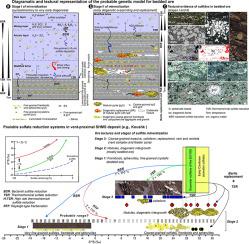当前位置:
X-MOL 学术
›
Ore Geol. Rev.
›
论文详情
Our official English website, www.x-mol.net, welcomes your
feedback! (Note: you will need to create a separate account there.)
The world-class Koushk Zn-Pb deposit, Central Iran: A genetic model for vent-proximal shale-hosted massive sulfide (SHMS) deposits – Based on paragenesis and stable isotope geochemistry
Ore Geology Reviews ( IF 3.2 ) Pub Date : 2020-09-01 , DOI: 10.1016/j.oregeorev.2020.103654 Abdorrahman Rajabi , Pura Alfonso , Carles Canet , Ebrahim Rastad , Shojaedin Niroomand , Soroush Modabberi , Pouria Mahmoodi
Ore Geology Reviews ( IF 3.2 ) Pub Date : 2020-09-01 , DOI: 10.1016/j.oregeorev.2020.103654 Abdorrahman Rajabi , Pura Alfonso , Carles Canet , Ebrahim Rastad , Shojaedin Niroomand , Soroush Modabberi , Pouria Mahmoodi

|
Abstract The Koushk Zn-Pb deposit is the largest known and least deformed and non-metamorphosed Early Cambrian shale-hosted massive sulfide (SHMS) deposit at Central Iran. The current remaining reserves are estimated to be greater than 14 Mt ore, averaging 7% Zn and 1.5% Pb; the primary resources ore of the deposit is estimated to be more than 60 Mt. At this deposit, different hydrothermal ore styles (bedded ore, vent complex, and feeder zone) are well preserved within the Lower Cambrian black siltstones and shales. According to fluid-rock interaction and different ore-forming processes in SHMS systems, these ore facies with extensive hydrothermal alteration provide unique conditions to understand critical textural and geochemical frameworks to present a genetic model. In this research, we focus on different paragenetic stages of sulfide mineralization and fluid-rock interactions in different ore styles from the Koushk SHMS deposit. The paragenetic relationship provides the context for the interpretation of stable isotopes (S, C, and O) in hydrothermal sulfides and carbonates. Detailed petrography and paragenetic studies represent three major generations of sulfide mineralizations at different ore zones: (1) stage I includes very fine-grained ( Textural relationships and S isotope data reveal that the contribution of bacterial sulfate reduction (BSR) in the Zn-Pb mineralization is not so significant, but the thermochemical sulfate reduction (TSR) nd direct barite replacement could provide sufficient sulfur for the main sulfide mineralization in the SHMS deposits. Also, the data presented in this paper are against a syngenetic, purely synsedimentary-exhalative model, and give prominence to that vent-proximal SHMS deposits formed predominantly during the diagenesis in the uppermost sediment pile and replacement of host rocks during vent complex development (VCD) processes.
中文翻译:

伊朗中部世界一流的 Koushk Zn-Pb 矿床:近喷口页岩蕴藏的块状硫化物 (SHMS) 矿床的成因模型——基于共生和稳定同位素地球化学
摘要 Koushk Zn-Pb 矿床是伊朗中部已知最大、变形和未变质的早寒武世页岩含块状硫化物(SHMS)矿床。目前剩余储量估计大于 14 Mt 矿石,平均 7% Zn 和 1.5% Pb;该矿床的主要资源矿石估计超过60 Mt。在该矿床中,下寒武统黑色粉砂岩和页岩中保存了不同的热液矿石类型(层状矿石、喷口杂岩和馈线带)。根据SHMS系统中流体-岩石相互作用和不同的成矿过程,这些具有广泛热液蚀变的矿相为理解关键的构造和地球化学框架提供了独特的条件,以呈现成因模型。在这项研究中,我们关注 Koushk SHMS 矿床不同矿石类型中硫化物成矿的不同共生阶段和流体-岩石相互作用。共生关系为解释热液硫化物和碳酸盐中的稳定同位素(S、C 和 O)提供了背景。详细的岩相学和共生研究代表了不同矿区的三代主要硫化物矿化:(1) 阶段 I 包括非常细粒度的 (纹理关系和 S 同位素数据表明细菌硫酸盐还原 (BSR) 在 Zn-Pb 中的贡献矿化作用不那么显着,但热化学硫酸盐还原 (TSR) 和重晶石直接置换可为 SHMS 矿床中的主要硫化物矿化提供足够的硫。此外,本文提供的数据与同生相背离,
更新日期:2020-09-01
中文翻译:

伊朗中部世界一流的 Koushk Zn-Pb 矿床:近喷口页岩蕴藏的块状硫化物 (SHMS) 矿床的成因模型——基于共生和稳定同位素地球化学
摘要 Koushk Zn-Pb 矿床是伊朗中部已知最大、变形和未变质的早寒武世页岩含块状硫化物(SHMS)矿床。目前剩余储量估计大于 14 Mt 矿石,平均 7% Zn 和 1.5% Pb;该矿床的主要资源矿石估计超过60 Mt。在该矿床中,下寒武统黑色粉砂岩和页岩中保存了不同的热液矿石类型(层状矿石、喷口杂岩和馈线带)。根据SHMS系统中流体-岩石相互作用和不同的成矿过程,这些具有广泛热液蚀变的矿相为理解关键的构造和地球化学框架提供了独特的条件,以呈现成因模型。在这项研究中,我们关注 Koushk SHMS 矿床不同矿石类型中硫化物成矿的不同共生阶段和流体-岩石相互作用。共生关系为解释热液硫化物和碳酸盐中的稳定同位素(S、C 和 O)提供了背景。详细的岩相学和共生研究代表了不同矿区的三代主要硫化物矿化:(1) 阶段 I 包括非常细粒度的 (纹理关系和 S 同位素数据表明细菌硫酸盐还原 (BSR) 在 Zn-Pb 中的贡献矿化作用不那么显着,但热化学硫酸盐还原 (TSR) 和重晶石直接置换可为 SHMS 矿床中的主要硫化物矿化提供足够的硫。此外,本文提供的数据与同生相背离,









































 京公网安备 11010802027423号
京公网安备 11010802027423号